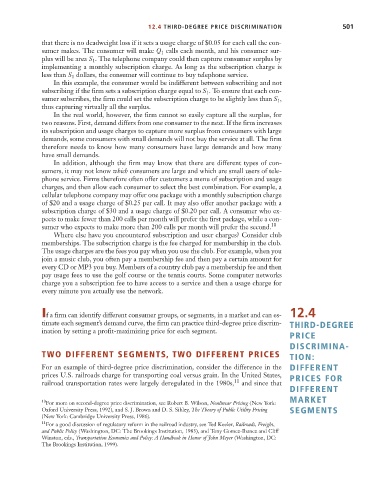Page 527 - Microeconomics, Fourth Edition
P. 527
c12capturingsurplus.qxd 7/22/10 10:41 AM Page 501
12.4 THIRD-DEGREE PRICE DISCRIMINATION 501
that there is no deadweight loss if it sets a usage charge of $0.05 for each call the con-
sumer makes. The consumer will make Q 1 calls each month, and his consumer sur-
plus will be area S . The telephone company could then capture consumer surplus by
1
implementing a monthly subscription charge. As long as the subscription charge is
less than S dollars, the consumer will continue to buy telephone service.
1
In this example, the consumer would be indifferent between subscribing and not
subscribing if the firm sets a subscription charge equal to S . To ensure that each con-
1
sumer subscribes, the firm could set the subscription charge to be slightly less than S ,
1
thus capturing virtually all the surplus.
In the real world, however, the firm cannot so easily capture all the surplus, for
two reasons. First, demand differs from one consumer to the next. If the firm increases
its subscription and usage charges to capture more surplus from consumers with large
demands, some consumers with small demands will not buy the service at all. The firm
therefore needs to know how many consumers have large demands and how many
have small demands.
In addition, although the firm may know that there are different types of con-
sumers, it may not know which consumers are large and which are small users of tele-
phone service. Firms therefore often offer customers a menu of subscription and usage
charges, and then allow each consumer to select the best combination. For example, a
cellular telephone company may offer one package with a monthly subscription charge
of $20 and a usage charge of $0.25 per call. It may also offer another package with a
subscription charge of $30 and a usage charge of $0.20 per call. A consumer who ex-
pects to make fewer than 200 calls per month will prefer the first package, while a con-
sumer who expects to make more than 200 calls per month will prefer the second. 10
Where else have you encountered subscription and user charges? Consider club
memberships. The subscription charge is the fee charged for membership in the club.
The usage charges are the fees you pay when you use the club. For example, when you
join a music club, you often pay a membership fee and then pay a certain amount for
every CD or MP3 you buy. Members of a country club pay a membership fee and then
pay usage fees to use the golf course or the tennis courts. Some computer networks
charge you a subscription fee to have access to a service and then a usage charge for
every minute you actually use the network.
If a firm can identify different consumer groups, or segments, in a market and can es- 12.4
timate each segment’s demand curve, the firm can practice third-degree price discrim- THIRD-DEGREE
ination by setting a profit-maximizing price for each segment.
PRICE
DISCRIMINA-
TWO DIFFERENT SEGMENTS, TWO DIFFERENT PRICES TION:
For an example of third-degree price discrimination, consider the difference in the DIFFERENT
prices U.S. railroads charge for transporting coal versus grain. In the United States, PRICES FOR
railroad transportation rates were largely deregulated in the 1980s, 11 and since that
DIFFERENT
10 For more on second-degree price discrimination, see Robert B. Wilson, Nonlinear Pricing (New York: MARKET
Oxford University Press, 1992), and S. J. Brown and D. S. Sibley, The Theory of Public Utility Pricing SEGMENTS
(New York: Cambridge University Press, 1986).
11 For a good discussion of regulatory reform in the railroad industry, see Ted Keeler, Railroads, Freight,
and Public Policy (Washington, DC: The Brookings Institution, 1983), and Tony Gomez-Ibanez and Cliff
Winston, eds., Transportation Economics and Policy: A Handbook in Honor of John Meyer (Washington, DC:
The Brookings Institution, 1999).

